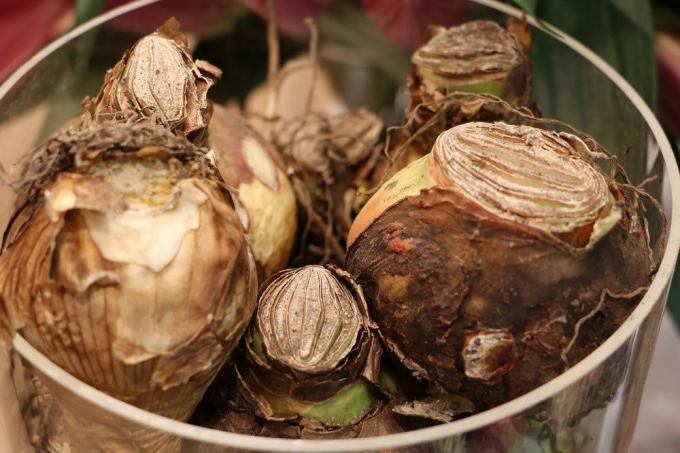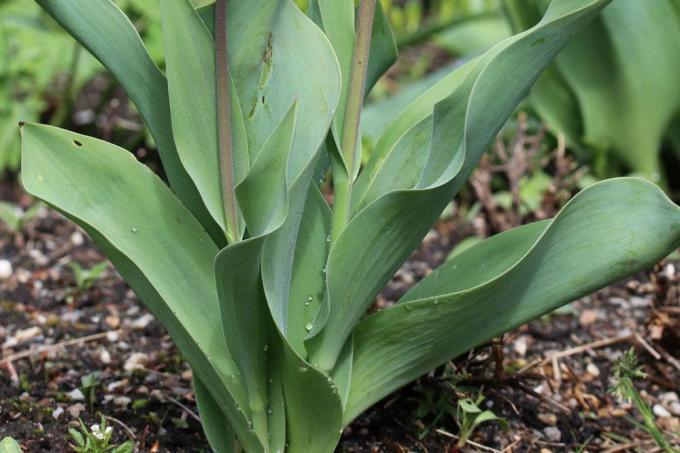
table of contents
- Toxicity
- Likelihood of confusion
- Plant parts
- blossom
- prevention
- First aid
Colorful, graceful and timelessly elegant: tulips are decorative heralds of spring that inspire flower lovers all over the world. The magnificent plants, which originally come from southern Europe and Asia, decorate gardens, balconies or terraces. However, one question is causing uncertainty: Are tulips poisonous? After all, parents and pet owners are often warned about this genus of flowers. We have clearly summarized the most important information about the tulip and can tell you whether this garden beauty poses a serious danger.
Toxicity
The tulip - poisonous in all parts of the plant
Tulips are not only pretty to look at, but also poisonous in all parts. Onions, stems and petals contain harmful tuliposides, which cause both skin irritation and acute symptoms of intoxication. Prolonged skin contact with tulip flowers or other parts of the plant can cause eczematous changes, itching and redness. In individual cases, painful swellings or small cracks in the skin occur. Tip: Always use gardening gloves when planting tulip bulbs. After direct skin contact, you should wash the affected areas thoroughly with water.
Likelihood of confusion
Caution, risk of confusion: tulip bulb or table onion?
Tulip bulbs, which have a particularly high concentration of toxins, look very similar to our table onions. If they are accidentally ingested by children or adults, the following symptoms are to be feared.
- increased salivation
- stomach pain
- Vomit
- shock
- apathy
- Drop in body temperature

Plant parts
In rare cases, accidental swallowing of the tulip bulb can even result in life-threatening circulatory or respiratory arrest. Although tulip leaves are less toxic than tulip bulbs, they can cause severe stomach and intestinal problems in children, the elderly or pets. For this reason, the flowers of the tulip should never be used as table decorations or kept in the kitchen. You don't want to do without colorful flower arrangements on your dining table? Then you can safely opt for edible flowers such as roses, violets or daisies, which are pleasing to the eye and guaranteed not to contain any toxic substances.
blossom
Tulip flowers - toxicity to dogs, cats and rodents
The flowers, stems and bulbs of a tulip are not only inedible for humans, but also for our pets. Since tulips release their toxins into the flower water, even drinking from saucers or vases can cause acute stomach problems. Pets that have nibbled extensively on tulip flowers show typical signs of intoxication such as the following.
- salivation
- nausea
- diarrhea
- Vomit
- Refusal to eat
Rodents such as rabbits, guinea pigs and hamsters, who like to eat juicy plants, are particularly at risk of poisoning. But dogs and cats must also be kept away from the tulip and its flowers.

prevention
Targeted prevention protects against health problems
If you plan to plant or prune tulips in your garden, you should only do so with appropriate protective equipment. Wear gloves and long-sleeved clothing to avoid unwanted skin contact. Do you have young children who like to pick colorful flowers? Or do you have pets that roam freely in the garden? Then you'd better not take any risks and completely avoid poisonous plants. We can assure you that there are numerous non-toxic alternatives that can turn your garden or terrace into a blooming oasis. Tip: rose, lilac, Jasmine and hydrangea are not only an asset to any green area, but also absolutely harmless to humans and animals. Are you looking for more non-toxic flowering plants for your home? Nurseries or wholesale flower markets have a huge selection for plant lovers all year round.
First aid
First aid in case of poisoning
Redness and irritation of the skin caused by direct contact with the tulip usually heals without treatment. Have your children or pets nibbled on a tulip leaf in an unobserved moment and only a tiny piece if swallowed, you can give them plenty of water to drink or give them activated charcoal to remove the pollutants neutralize. If, on the other hand, it is suspected that larger quantities have been ingested, a doctor or veterinarian must be contacted immediately. The medically trained staff will decide on a case-by-case basis which treatment steps are to be initiated.

Conclusion: tulips are poisonous for humans and animals
The toxicity of the tulip cannot be denied and can pose a serious threat to health. Even a single skin contact with the tulip bulb or the tulip leaves can cause painful irritation. Inadvertent consumption of these parts of the plant triggers acute symptoms of poisoning and usually requires medical treatment. For this reason, always approach the colorful spring flowers with due caution. Families with small children or pet owners, on the other hand, should completely refrain from using tulips and preferably decorate their home with non-toxic flowers.
Sources:
http://www.gizbonn.de/233.0.html
http://www.botanikus.de/Gift/tulpe.html
https://www.garten-treffpunkt.de/lexikon/pflanzengifte.aspx
http://www.alte-sonnen-apotheke.de/tipps-fuer-haus-und-garten/ungiftige-gartenpflanzen.html

